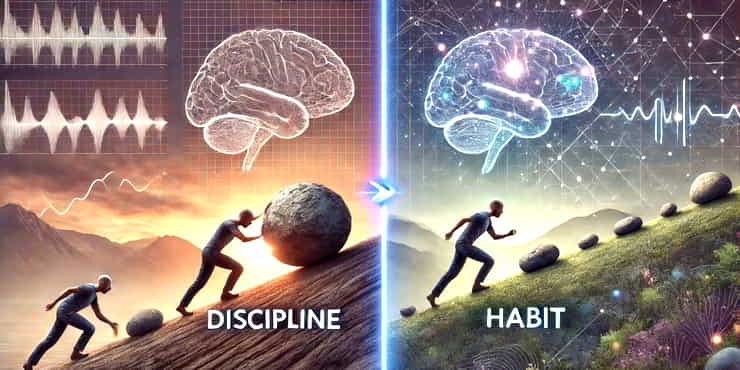Discipline vs Habit: What’s the Real Productivity Driver?

Estimated reading time: 6 Min
| Discipline vs habit: which is the driver? Learn the key differences—and how to turn discipline into lasting habits that support your goals. |
Another quick question: When is discipline not really discipline?
The answer might surprise you.
It’s when that disciplined action becomes a habit.
Understanding this transformation sheds light on how our brains work and how we can leverage this knowledge to improve our lives.
Here, we explore the fascinating world of the subconscious mind and see how our habits are formed.
Understanding the Brain’s Role
Our brain is a complex organ responsible for every action, thought, and feeling we experience.
It’s like having a natural supercomputer, controlling everything we do through a vast network of neurons.
These neurons form connections based on our experiences, creating what we call our subconscious mind.
The subconscious mind is incredibly powerful.
It’s the part of our brain that handles everything on autopilot.
From breathing and blinking to more complex behaviours like driving a car or typing on a keyboard, the subconscious mind keeps things running smoothly, mostly without us thinking about it.
The Subconscious Mindset
So, what exactly is our subconscious mindset?
Think of it as a storage space for all our values, beliefs, and experiences.
Over time, these elements build up and shape how we see the world and how we react to it.
This mindset is sometimes referred to as our self-image or ego.
Our mindset is like an internal filter.
The values and beliefs we’ve accumulated over the years shape our internal filter, through which every thought, feeling, or action passes.
Most of the time, we’re not even aware of this process.
Our subconscious mind operates behind the scenes, influencing our decisions without us realising it.
The Nature of Habits
This brings us to habits.
A habit is something done often, something that is not thought about; it’s just done.
A discipline is a conscious decision or effort to do, or try to do, what is proper, expected, or desired.
“Habits” is the word we use to describe behaviours that we perform automatically, without much conscious thought.
They start as deliberate actions, often requiring discipline to perform consistently.
But over time, as we repeat these actions, they become ingrained in our subconscious.
This is when discipline transforms into habit.
For instance, consider brushing your teeth every morning. Initially, it might have required a lot of reminders from your parents.
But now, you do it without even thinking about it.
It’s become a habit, a routine part of your day.
This shift from disciplined action to automatic habit is all thanks to your subconscious mind.
The Intersection of Habits and Addictions
Now, let’s talk about addictions.
Addictions can be seen as unwanted habits, often harmful, that are deeply embedded in our subconscious.
Just like habits, addictions form through repeated actions and thoughts.
However, they typically have negative consequences and can be difficult to break.
Our subconscious mind doesn’t distinguish between good and bad habits.
It simply reinforces whatever we repeatedly do.
This is why breaking an addiction can be so challenging.
It’s not just about stopping a behaviour; it’s about reprogramming our subconscious mind to eliminate the desire for that behaviour.
Over time, our subconscious mind builds up programming that supports these addictions.
The same neural pathways that support our positive habits also support our unwanted habits, whether it’s smoking, overeating, or excessive screen time.
Indirect Control Over Our Mindset
So what about our conscious mind?

The relationship between our conscious and subconscious minds is complex.
While we don’t have direct control over our subconscious, we can influence it indirectly.
Our mindset is like having a gatekeeper for our brain, filtering requests through the values and beliefs we’ve accumulated.
However, with the right techniques, we can start to reprogram this filter to better align with our conscious goals.
Positive Affirmations
One powerful technique is using positive affirmations.
These are simple, positive statements that you repeat to yourself regularly.
The idea is to gradually overwrite negative or limiting beliefs stored in your subconscious with positive ones.
For example, saying, “I am confident and capable” can slowly shift your self-image, encouraging more confident behaviour.
It does take some time so patience is essential.
Visualisation
Visualisation is another effective method.
By vividly imagining achieving your goals, you create mental images that your subconscious mind starts to accept as reality.
Vivid visualisation will include what you hear and feel in addition to what you see.
This process can help rewire your brain, making it easier to achieve those goals in real life.
Athletes often use visualisation to enhance their performance, mentally rehearsing their moves to improve actual performance.
Mindfulness and Meditation
Practices like mindfulness and meditation can also help.
These techniques increase your awareness of your thoughts and feelings, making it easier to identify negative patterns influenced by your subconscious.
With this awareness, you can start to challenge and change these patterns, fostering a more positive mindset.
Practical Applications
Understanding how habits form and how we can influence our subconscious mind opens up many practical applications.
Whether you’re looking to develop positive habits or break free from negative ones, the following strategies can help.
Developing Positive Habits
To create beneficial habits, start small and be consistent.
Choose a positive action, like exercising or reading, and incorporate it into your daily routine.
Use reminders and rewards to reinforce the habit until it becomes automatic.
Remember, it’s the repetition that helps engrain the habit into your subconscious.
Overcoming Negative Habits
Breaking free from unwanted habits requires a similar approach.
Identify the triggers that lead to the negative behaviour and find healthier alternatives.
For example, if stress leads you to unhealthy snacking, try replacing it with a short walk or a few minutes of deep breathing.
Consistently applying these new behaviours can help reprogram your subconscious mind.
Consistency and Patience
Remember, changing your mindset and habits takes time.
Consistency is key, as is patience.
It’s important to recognise that setbacks are a natural part of the process.
Keep focusing on your long-term goals, and remember that every small step forward is progress.
FAQs: Discipline vs Habit
What is the subconscious mind?
The subconscious mind is the part of the brain that stores our values, beliefs, and experiences, influencing our automatic responses and behaviours.
How do habits form in the brain?
Habits form through repeated actions and thoughts, creating neural pathways in the brain that make these actions automatic over time.
Can we change our subconscious mind?
Yes, we can influence our subconscious mind indirectly through positive affirmations, visualisation, mindfulness, and consistent practice.
What is the difference between a habit and an addiction?
A habit is a regular practice that can be positive or negative, while an addiction is a harmful habit that often causes significant negative impacts on one’s life.
How long does it take to form a new habit?
It varies, but research suggests it can take anywhere from 18 to 254 days to form a new habit, depending on the complexity of the behaviour and the individual.
Is there a faster way to make changes?
Yes, there is, with practice. I’ve achieved excellent results using the “6 Step Reframing” technique from Neuro-linguistic Programming (NLP).
Summary
In summary, discipline transforms into habit through the power of our subconscious mind.
By understanding how our subconscious works, we can better control our actions and reactions.
Through techniques like positive affirmations, visualisation, and mindfulness, we can influence our mindset and create lasting, positive change.
Remember, it’s not just about what we do, but how we consistently shape our thoughts and behaviours that lead to meaningful transformation.
In conclusion, developing discipline is a vital aspect of achieving success in any area of life.
However, discipline is not always discipline.
When it’s a habit, it’s a different story altogether.
Habits are challenging to break, while discipline requires conscious effort.
Developing discipline takes time and effort, but it’s worth it in the end. With discipline, you can achieve anything you set your mind to.
Remember that habits can be changed, and discipline can be developed.
You have the power to control your subconscious mind and change your mindset.
With the right mindset and habits, you can achieve anything you want in life.
So, go out there and develop the discipline you need to succeed!
😉
Richard






